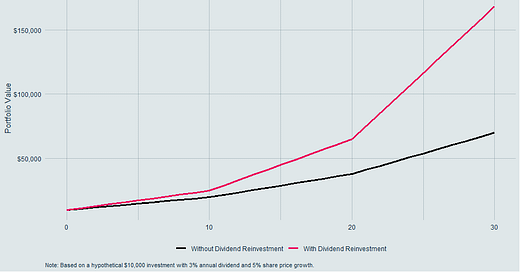The Hidden Engine of Wealth Creation
When investors discuss strategies for building wealth in the stock market, they often focus on identifying promising companies, timing market entries and exits, or selecting the right sectors. Yet one of the most powerful wealth-building mechanisms remains curiously underappreciated: dividend reinvestment. This simple but potent strategy has created more millionaires than perhaps any other investment approach, working quietly in the background while delivering exponential growth through the miracle of compounding.
What Are Dividends and Dividend Reinvestment?
Dividends are portions of a company's earnings distributed to shareholders, typically on a quarterly basis. When you own dividend-paying stocks, you have two options: collect these payments as cash income or reinvest them to purchase additional shares of the same stock. The latter approach—dividend reinvestment—sets in motion a wealth-building cycle that accelerates over time.
Rather than taking dividends as income, reinvesting them allows investors to acquire more shares without committing additional capital. These new shares then generate their own dividends, which purchase more shares, creating a snowball effect of wealth accumulation. This process harnesses the power of compound growth, where returns generate returns on themselves.
The Compounding Advantage
The mathematics behind dividend reinvestment is compelling. Consider a hypothetical $10,000 investment in a stable company paying a 3% annual dividend with modest share price growth of 5% annually:
After 10 years: ~$25,000 with dividends reinvested vs. ~$20,000 without
After 20 years: ~$65,000 with dividends reinvested vs. ~$38,000 without
After 30 years: ~$168,000 with dividends reinvested vs. ~$70,000 without
This dramatic difference demonstrates that dividend reinvestment doesn't just add to your returns—it multiplies them. The longer the time horizon, the more pronounced this multiplication effect becomes, as each reinvested dividend begins generating its own returns.
Real-World Evidence of Dividend Reinvestment Power
Historical performance data provides compelling evidence for the impact of dividend reinvestment. According to a study by Hartford Funds, from 1960 to 2022, approximately 84% of the total return of the S&P 500 came from reinvested dividends and the compounding effect they generated. Put differently, an investment that might have grown 9-fold with dividends taken as cash could have grown nearly 77-fold with dividends reinvested over this period.
Many of the most successful long-term investors attribute a significant portion of their wealth to this strategy. Warren Buffett, through Berkshire Hathaway, has consistently emphasized the power of compounding through reinvestment, albeit often through retained earnings rather than traditional dividends.
The Psychological Advantage
Beyond the mathematical advantages, dividend reinvestment offers psychological benefits that help investors succeed. By automating the reinvestment process through Dividend Reinvestment Plans (DRIPs) or brokerage settings, investors:
Avoid the temptation to time the market
Maintain disciplined investing habits regardless of market conditions
Practice "paying themselves first" without requiring active decision-making
Benefit from dollar-cost averaging as dividends purchase more shares when prices are low
This "set it and forget it" approach removes emotional decision-making from the equation, which research consistently shows improves investment outcomes over time.
Implementing a Dividend Reinvestment Strategy
The practical implementation of dividend reinvestment has never been easier. Most brokerages offer automatic dividend reinvestment options that can be enabled with a single click. Additionally, many companies offer Direct Stock Purchase Plans (DSPPs) and Dividend Reinvestment Plans (DRIPs) that allow investors to bypass brokerages altogether, often with reduced or eliminated fees.
For those building a dividend reinvestment portfolio, consider these principles:
Focus on dividend growth, not just yield: Companies that consistently increase their dividends over time provide a compounding accelerator effect.
Seek quality over quantity: High dividend yields can sometimes signal companies in distress. Prioritize companies with sustainable payout ratios, strong balance sheets, and competitive advantages.
Maintain a long-term perspective: The most dramatic benefits of dividend reinvestment emerge over decades, not months or years.
Consider tax implications: Hold dividend-paying stocks in tax-advantaged accounts when possible to maximize compounding.
Conclusion: The Patience Premium
The magic of dividend reinvestment might be best understood as a premium paid to patient investors. While active trading strategies come and go with market fashions, dividend reinvestment has quietly created substantial wealth for generations of investors willing to let time and mathematics work in their favor.
In a financial world often characterized by complexity and noise, dividend reinvestment stands out for its elegant simplicity. It requires no special timing skills, no complex analysis, and no constant monitoring—just an understanding of compounding and the discipline to allow this powerful force to work uninterrupted over time.
For investors seeking to build meaningful wealth, few strategies offer the proven track record and accessibility of systematic dividend reinvestment. It may lack the excitement of discovering the next high-flying growth stock, but its reliability and effectiveness have stood the test of time, creating financial security for countless investors who recognized its quiet magic.




